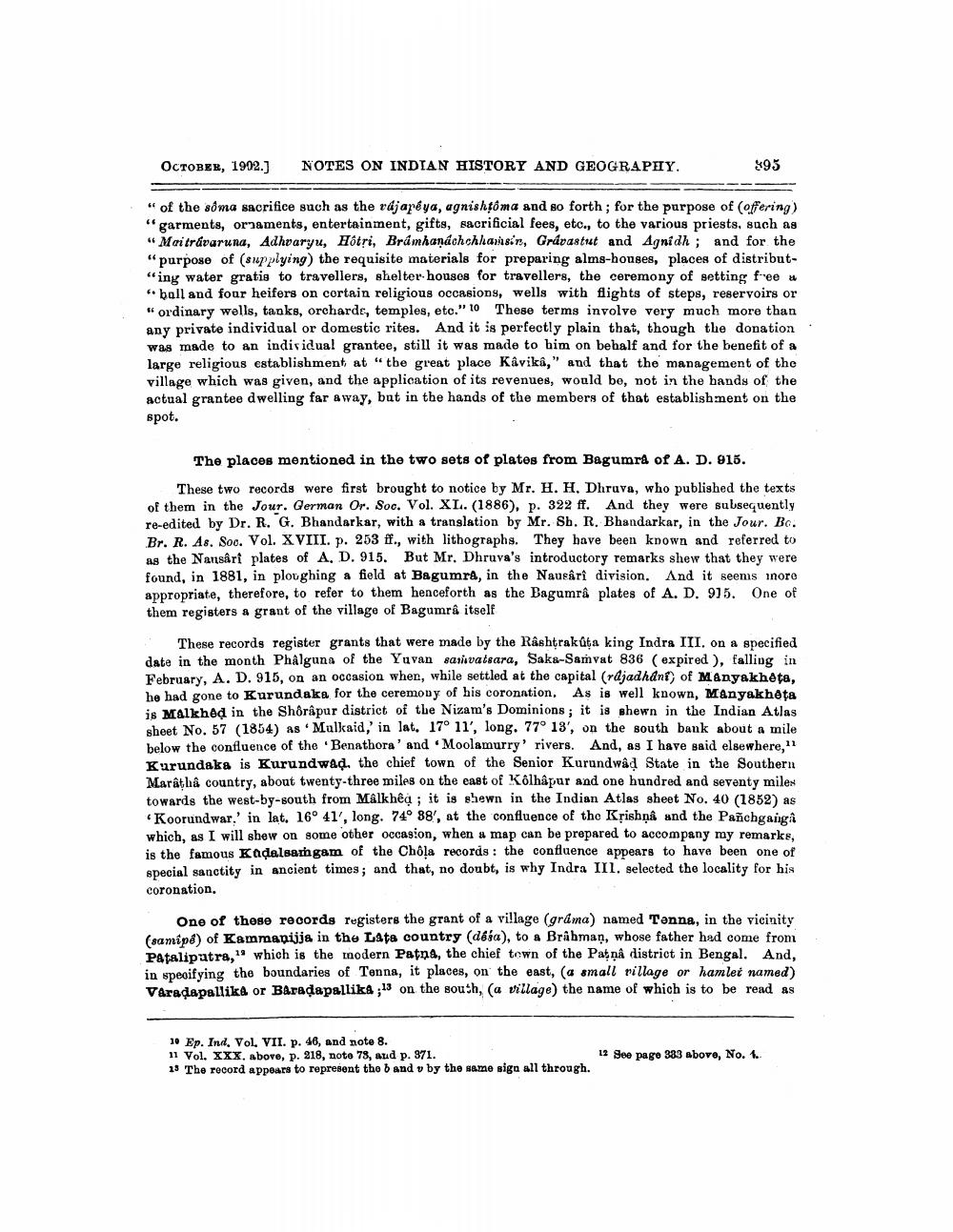________________
OCTOBER, 1902.]
NOTES ON INDIAN HISTORY AND GEOGRAPHY.
395
" of the sóma sacrifice such as the rájapéya, agnishtôma and so forth; for the purpose of offering) "garments, ornaments, entertainment, gifts, sacrificial fees, etc., to the various priests, such as "Mai travaruna, Adhvaryu, Hótri, Brámhandchchhansin, Grávastut and Agnidh; and for the "purpose of supplying the requisite materials for preparing alms-houses, places of distribut“ing water gratis to travellers, shelter houses for travellers, the ceremony of setting free # * ball and foar heifers on cortain religious occasions, wells with flights of steps, reservoirs or "ordinary wells, tanks, orcharde, temples, etc." 10 These terms involve very much more than any private individual or domestic rites. And it is perfectly plain that, though the donation was made to an individual grantee, still it was made to him on behalf and for the benefit of a large religious establishment at "the great place Kåvikâ," and that the management of the village which was given, and the application of its revenues, would be, not in the hands of the actual grantee dwelling far away, but in the hands of the members of that establishment on the spot.
The places mentioned in the two sets of plates from Bagumra of A. D. 915.
These two records were first brought to notice by Mr. H. H, Dhruva, who published the texts of them in the Jour. German Or. Soc. Vol. XL. (1886), p. 322 ff. And they were subsequently re-edited by Dr. R. G. Bhandarkar, with a translation by Mr. Sb. R. Bhandarkar, in the Jour. Bc. Br. R. As, Soo. Vol. XVIII. p. 253 ff., with lithographs. They have been known and referred to as the Nansari plates of A, D. 915. But Mr. Dhruva's introductory remarks shew that they were found, in 1881, in ploughing a field at Bagumra, in the Nausâri division. And it seems inore appropriate, therefore, to refer to them henceforth as the Bagumrå plates of A. D. 935. One of them registers a grant of the village of Bagumra itself
These records register grants that were made by the Râshtrakúta king Indra III. on a specified date in the month Phálguna of the Yuvan sari vatsara, Saka-Samvat 836 (expired ), falling in February, A. D. 915, on an occasion when, while settled at the capital (rdjadhani) of Manyakheța, he had gone to Kurundaka for the ceremony of his coronation. As is well known, Manyakhota is Mallhod in the Shorâpur district of the Nizam's Dominions; it is shewn in the Indian Atlas sheet No. 57 (1854) as Mulkaid,' in lat. 17° 11', long. 77° 13', on the south bank about a mile below the confluence of the Benathora' and Moolamurry' rivers. And, as I have said elsewhere,"1 Kurundaka is Kurundwad, the chief town of the Senior Kurandwad State in the Southern Maratha country, about twenty-three miles on the east of Kolhapur and one hundred and seventy miles towards the west-by-south from Malkhéa ; it is shewn in the Indian Atlas sheet No. 40 (1852) as
Koorundwar' in lat. 16° 41', long. 74° 88', at the confluence of the Krishna and the Panchganga which, as I will shew on some other occasion, when a map can be prepared to accompany my remarks, is the famous Kadalsargam of the Chola records: the confluence appears to have been one of special sanctity in ancient times; and that, no doubt, is why Indra II. selected the locality for his coronation.
One of those records registers the grant of a village (gráma) named Tonna, in the vicinity (samipá) of Kammanija in the Lata country (dása), to a Brahman, whose father had come from Patalipatra," which is the modern Patna, the chief town of the Patņa district in Bengal. And, in speoifying the boundaries of Tenna, it places, on the east, (a small village or hamlet named) Varadapallika or Baradapallika ;13 on the south, (a village) the name of which is to be read as
10 Ep. Ind. Vol. VII. p. 46, and note 8. 11 Vol. XXX. above, p. 218, note 78, aud p. 371. 15 The rocord appears to represent the band v by the same siga all through.
12 See page 383 above, No.




